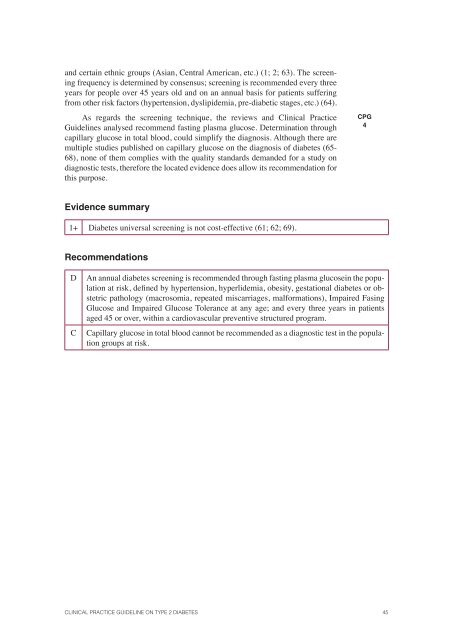2,46 Mb - GuÃaSalud
2,46 Mb - GuÃaSalud
2,46 Mb - GuÃaSalud
You also want an ePaper? Increase the reach of your titles
YUMPU automatically turns print PDFs into web optimized ePapers that Google loves.
and certain ethnic groups (Asian, Central American, etc.) (1; 2; 63). The screening<br />
frequency is determined by consensus; screening is recommended every three<br />
years for people over 45 years old and on an annual basis for patients suffering<br />
from other risk factors (hypertension, dyslipidemia, pre-diabetic stages, etc.) (64).<br />
As regards the screening technique, the reviews and Clinical Practice<br />
Guidelines analysed recommend fasting plasma glucose. Determination through<br />
capillary glucose in total blood, could simplify the diagnosis. Although there are<br />
multiple studies published on capillary glucose on the diagnosis of diabetes (65-<br />
68), none of them complies with the quality standards demanded for a study on<br />
diagnostic tests, therefore the located evidence does allow its recommendation for<br />
this purpose.<br />
CPG<br />
4<br />
Evidence summary<br />
1+ Diabetes universal screening is not cost-effective (61; 62; 69).<br />
Recommendations<br />
D<br />
C<br />
An annual diabetes screening is recommended through fasting plasma glucosein the population<br />
at risk, defined by hypertension, hyperlidemia, obesity, gestational diabetes or obstetric<br />
pathology (macrosomia, repeated miscarriages, malformations), Impaired Fasing<br />
Glucose and Impaired Glucose Tolerance at any age; and every three years in patients<br />
aged 45 or over, within a cardiovascular preventive structured program.<br />
Capillary glucose in total blood cannot be recommended as a diagnostic test in the population<br />
groups at risk.<br />
CLINICAL PRACTICE GUIDELINE ON TYPE 2 DIABETES 45

















